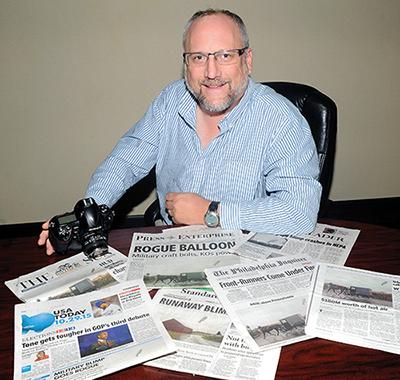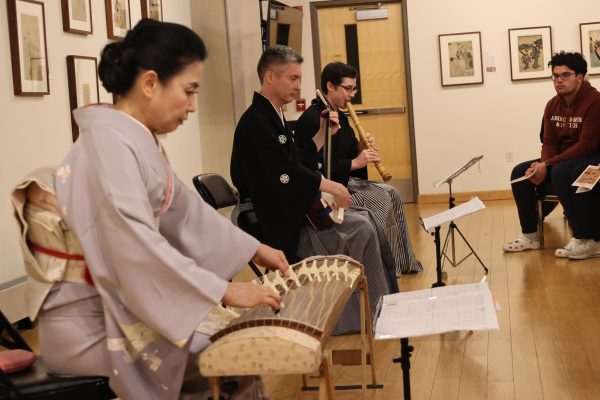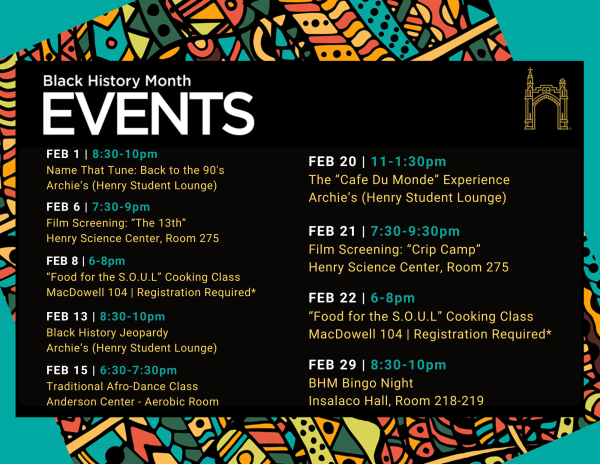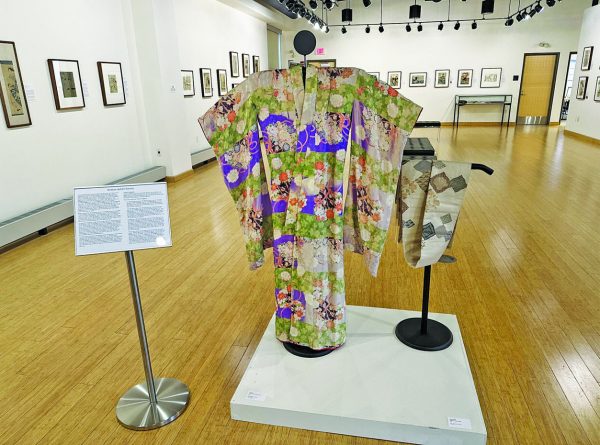Com Professor Takes Photo Seen ‘Round the World’

Jimmy May, adjunct professor in the communications department, took the defining photograph of the recent runaway Army balloon as it moved through Columbia County. Here he is seen with some of the newspapers that used his photograph.
November 30, 2015
Jimmy May, adjunct professor in the communications department, took the defining photograph of the recent runaway Army balloon as it moved through Columbia County.
May, who has taught photography courses in the department for longer than a decade, captured the blimp while on assignment for The Bloomsburg Press Enterprise.
While he chased the balloon through the countryside and took multiple shots, he searched for the perfect frame, one that would provide context. “While I was at the intersection, an Amish buggy I passed about a mile back came up on me, and I quickly changed lenses to take advantage of the buggy passing in the foreground to make the image more interesting, which worked very well,” he said.
After the buggy passed, May traveled in a different direction and captured multiple images, which he provided to The Associated Press, and all of his photos, particularly the Amish buggy shot, were published on the front pages of dozens of newspapers across the country, including USA Today, Washington Times, Los Angeles Times, The Star-Ledger, York Daily Record, Pittsburgh Tribune-Review, Pittsburgh Post-Gazette, The Philadelphia Inquirer, Baltimore Sun, The Journal Gazette and South Florida Sun Sentinel to name a few. The following day, Stars and Stripes Mideast Edition used one of the vertical images with the headline “Balloonacy in Pennsylvania.” NBC and CNN also ran the image on their broadcasts. The photo was widely shared on Facebook, and some of his Associated Press photos became APTOPIX images, which means they were marked as “best of the day.”
May said he was most honored when editors of The Associated Press listed his buggy photo as one of the top 10 photos of the week out of tens of thousands of images.
May did what he teaches his students to do: frame photographs that provide context and achieve larger narratives.
“It more than just grabbing a shot; it is thinking it through and knowing how you want it to look before you take the picture.”
Senior communications major Courtney Garloff said May taught her that great photographs are more than art: They document important social and political events in a way that no other medium can.
May has worked as a news photographer for more than 30 years and has earned more than 60 awards, including Pennsylvania Associated Press Managing Editors Awards, Pennsylvania Keystone Awards and Society of Professional Journalist photography awards. He has received awards every year of his career at Press Enterprise but one.
“I have had images printed in a two page spread, double truck, in Sports Illustrated about football in America and also a photojournalism magazine called Doubletruck. National Geographic used an image I shot to illustrate a story about the health of the Susquehanna River.”
The most well-known photo May took of campus is the image of the fireworks exploding over Mercy Hall after the university achieved university status.
May said still photography remains an important medium in publications – both print and Web – throughout the world.
“I can remember the bombing of the Oklahoma City Federal Building and what people will tell you is that they remember the image of the firefighter holding the boy. Just ask yourself what video images you remember from the news last evening.”
May’s instruction also led to one of his most cherished achievements: The photographs of student and protégé Mary Bove 2015 were published in The New York Times before she graduated, and she was selected from students throughout the world to intern at L.A. Weekly, a Pulitzer Prize-winning newspaper.






